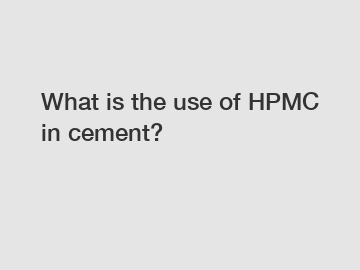Dec. 12, 2023
Chemicals
What is the use of HPMC in cement? A closer look at the role of Hydroxypropyl Methylcellulose in the construction industry.
Hydroxypropyl Methylcellulose (HPMC) is a widely used additive in the construction industry, particularly in the manufacturing of cement-based products. This versatile compound offers several benefits that enhance the properties of cement, making it a popular choice among builders and contractors worldwide. So, what exactly is the use of HPMC in cement? Let's explore this question further.
1. Improved workability:

One of the primary reasons for using HPMC in cement is its ability to improve workability. When added to a cement mix, HPMC acts as a lubricant, reducing friction between particles and enhancing flowability. This makes it easier for contractors to place the cement and achieve a smooth finish. The increased workability also allows for better consolidation, reducing the risk of voids and improving overall strength and durability.
2. Water retention:
Another significant advantage of incorporating HPMC into cement is its capacity to retain water. HPMC forms a film around cement particles, preventing excessive evaporation of water during the hydration process. This leads to a more uniform curing and enhanced hydration, resulting in improved mechanical properties of the final product. The water retention ability of HPMC is particularly crucial in hot and dry climates or when working with fast-setting cement.
3. Increased adhesion:
HPMC also acts as an excellent adhesive in cement-based products. It improves the bond between the cementitious material and other substrates, such as tiles, ceramics, or insulation materials. This enhanced adhesion prevents debonding or detachment of the applied materials, ensuring the long-term integrity of the construction. HPMC's adhesive properties make it an indispensable component in tile adhesives, renders, and waterproofing coatings.
4. Enhanced durability:
The addition of HPMC in cement can significantly enhance the durability of the final product. HPMC forms a protective barrier around cement particles, reducing the ingress of water, aggressive chemicals, and pollutants. This protective layer minimizes the risks of corrosion, efflorescence, and deterioration, thus prolonging the life expectancy of the structure. Moreover, HPMC's water resistance properties make it an ideal choice for exterior applications, where exposure to harsh weather conditions is imminent.
5. Improved crack resistance:
Incorporating HPMC into cement can also improve the crack resistance of the material. HPMC acts as a plasticizer, increasing the flexibility and elasticity of the hardened cement paste. This prevents the formation of cracks under various stress conditions, such as shrinkage, thermal expansion, or external loads. By minimizing the occurrence of cracks, HPMC helps to maintain the structural integrity and aesthetic appeal of the construction.
In conclusion, Hydroxypropyl Methylcellulose (HPMC) plays a vital role in the construction industry as an additive in cement-based products. Its inclusion offers numerous benefits, including improved workability, better water retention, increased adhesion, enhanced durability, and improved crack resistance. These properties contribute to the overall performance and longevity of cement-based constructions. As the demand for high-quality, long-lasting structures continues to grow, the use of HPMC in cement is likely to become even more prevalent in the years to come. So, next time you see a well-finished concrete surface or a sturdy tiled wall, remember that HPMC might have played a significant role in achieving such excellence.
Are you interested in learning more about hpmc for gypsum based plastering mortar, HPMC manufacturers, HPMC for construction? Contact us today to secure an expert consultation!
If you are interested in sending in a Guest Blogger Submission,welcome to write for us!
All Comments ( 0 )